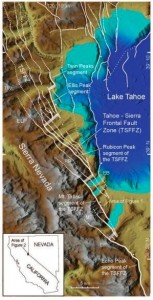Study shows a 6.9 quake possible in Lake Tahoe
By ScienceDaily
Results of a new U.S. Geological Survey study conclude that faults west of Lake Tahoe, referred to as the Tahoe-Sierra frontal fault zone, pose a substantial increase in the seismic hazard assessment for the Lake Tahoe region of California and Nevada, and could potentially generate earthquakes with magnitudes ranging from 6.3 to 6.9.
A close association of landslide deposits and active faults also suggests that there is an earthquake-induced landslide hazard along the steep fault-formed range front west of Lake Tahoe.

Faults lines are dashed where approximately located, dotted where concealed, bar and ball on downthrown side. Heavier line weight shows principal range-front fault strands of the Tahoe-Sierra frontal fault zone. Opaque white boxes indicate approximate segment boundaries and right steps in range front separating principal fault strands. Map/James Howle-USGS
Using a new high-resolution imaging technology, known as bare-earth airborne LiDAR (Light Detection And Ranging), combined with field observations and modern geochronology, USGS scientists, and their colleagues from UNR; UC Berkeley; and the U.S. Army Corps of Engineers, have confirmed the existence of previously suspected faults. LiDAR imagery allows scientists to “see” through dense forest cover and recognize earthquake faults that are not detectable with conventional aerial photography.
“This study is yet one more stunning example of how the availability of LiDAR information to precisely and accurately map the shape of the solid Earth surface beneath vegetation is revolutionizing the geosciences,” said USGS Director Marcia McNutt. “From investigations of geologic hazards to calculations of carbon stored in the forest canopy to simply making the most accurate maps possible, LiDAR returns its investment many times over.”
Motion on the faults has offset linear moraines (the boulders, cobbles, gravel, and sand deposited by an advancing glacier) providing a record of tectonic deformation since the moraines were deposited. The authors developed new three-dimensional techniques to measure the amount of tectonic displacement of moraine crests caused by repeated earthquakes. Dating of the moraines from the last two glaciations in the Tahoe basin, around 21 thousand and 70 thousand years ago, allowed the study authors to calculate the rates of tectonic displacement.